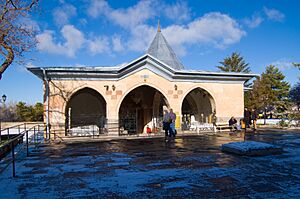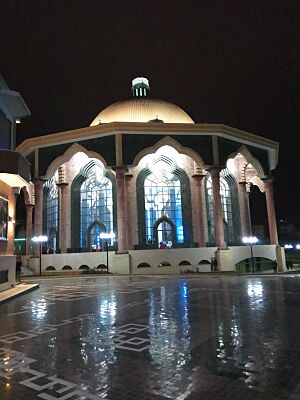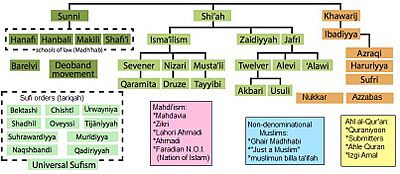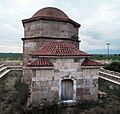Bektashism facts for kids

Flag of Bektashism, as seen at the World Headquarters of the Bektashi.
|
|
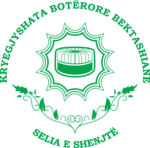
Emblem of Bektashism
|
|
| Abbreviation | Bektashism |
|---|---|
| Type | Dervish order |
| Headquarters | World Headquarters of the Bektashi, Tirana (previously Haji Bektash Veli Complex, Nevşehir) |
|
Region
|
Albania, Bulgaria, Greece, Kosovo, North Macedonia, Turkey, other Albanian and Turkish diaspora |
|
Dedebaba
|
Baba Mondi |
|
Key people
|
|
Bektashism is a special path within Sufism, which is a mystical form of Islam. It started in the 1200s in Anatolia (modern-day Turkey) and became popular in the Ottoman Empire. The group is named after a holy person named Haji Bektash Veli. People who follow this path are called Bektashis.
Today, the Bektashi community is led by Baba Mondi. He is the eighth leader, known as the Dedebaba. The main center for Bektashis is the World Headquarters of the Bektashi in Tirana, the capital of Albania.
Bektashism began as a part of Sunni Islam. But by the 1500s, it had mixed in ideas from Twelver Shi'ism. This included a deep respect for Ali, who was the cousin and son-in-law of the Prophet Muhammad, and the Twelve Imams.
The Bektashis were very important in the Ottoman Empire, especially because of their connection to the Janissary Corps, the empire's best soldiers. When the modern country of Turkey was formed, its leader, Mustafa Kemal Atatürk, banned many religious groups. Because of this, the Bektashi headquarters moved to Albania.
Estimates from 2005 suggest there are over seven million Bektashis around the world. They live mostly in Turkey, Albania, and other parts of the Balkans.
Contents
History of the Bektashi Order

How Bektashism Began
Bektashism started with the followers of Haji Bektash Veli, a wise scholar from the 13th century. The rules and rituals of the Bektashis were later organized by a mystic named Balım Sultan. He is so important that Bektashis call him the "Second Elder."
The group became very popular in the Ottoman Empire. They had spiritual centers called tekkes all over Anatolia and the Balkans. They were the official order of the Janissaries, the top soldiers of the Ottoman army. This made them very influential.
A Time of Trouble
In 1826, Sultan Mahmud II banned the Bektashi order because of its strong ties to the Janissaries, whom he had broken up. Many Bektashi leaders were sent away, and their tekkes were destroyed.
The Bektashis slowly got their freedom back. But after the Republic of Turkey was created, the government shut down the tekkes again in 1925. This forced the Bektashi leaders to move their main center to Tirana, Albania.
Bektashism in the Balkans
The Bektashi order had a big impact in the Balkans, especially in Albania and Bulgaria. By the 18th century, it was very popular in southern Albania.
After the communists took power in Albania in 1945, they made it very hard for religious groups. In 1967, all religion was banned, and all Bektashi tekkes were closed. When the ban ended in 1990, Bektashism was re-established. Today, many Bektashis live in Albania, North Macedonia, and Kosovo.
A New Sovereign State
On September 21, 2024, Albanian Prime Minister Edi Rama announced plans to create the Sovereign State of the Bektashi Order. This would be a tiny, independent state inside the city of Tirana, similar to Vatican City. The goal is to promote religious tolerance and a peaceful form of Islam.
What Bektashis Believe
Bektashis believe in one God and follow the teachings of all Islamic prophets. They have special respect for Haji Bektash Veli, who they believe was a descendant of Ali, the Prophet Muhammad's cousin.
Unlike some other Muslims, Bektashis respect all of the Prophet Muhammad's close friends, called the Companions of the Prophet. However, they see Ali as the greatest among them.
The Four Gates to Truth
Like other Sufi groups, Bektashis believe in a spiritual journey to find truth. They say a person must pass through four "gates":
- Sharī'a: The religious law that guides daily life.
- Ṭarīqa: The spiritual path, where a person learns from a guide.
- Ma'rifa: True, deep knowledge of God.
- Ḥaqīqa: The final truth, or reality itself.
To travel this path, a person needs an experienced spiritual guide, called a baba.
Special Practices and Holidays
Bektashis have their own unique practices. They hold a special ritual meal called a muhabbet. They also celebrate Nowruz, the Persian New Year, as the birthday of Ali.
They have a deep respect for the Quran, but they also believe it has a hidden, mystical meaning. Their understanding of the faith is often passed down through poetry and stories. The famous Turkish poet Yunus Emre is believed to have been a Bektashi.
How the Community Is Organized
The Bektashi community has a clear structure, like a ladder. Members can move up through different ranks as they grow spiritually.
- Aşık: A person who is interested in the order but has not yet joined.
- Mühip: A member who has been officially welcomed into the order.
- Dervish: A member who has taken more serious vows and lives a spiritual life.
- Baba: A "father" who leads a tekke (spiritual center) and can guide others.
- Halife-baba: A "grandfather" who is a senior leader.
- Dedebaba: The "great-grandfather," who is the highest leader of the entire Bektashi order.
Traditionally, the Dedebaba lived at the main shrine of Haji Bektash Veli in Turkey. Today, the Dedebaba is based at the World Headquarters in Tirana, Albania.
List of Dedebabas (Supreme Leaders)
This is a list of the Dedebabas who have led the Bektashi Order.
Leaders in Turkey (before 1930)
These leaders were mostly based in Hacıbektaş, Turkey, before the headquarters moved to Albania.
- Haji Bektash Veli (1282-1341)
- Balım Sultan (1509-1516)
- Sersem Ali Dede Baba (1551–1569)
- Mehmed Ali Hilmi Dede Baba (1879–1907)
- Sali Njazi Dede Baba (1913–1925)
Leaders in Albania (1930–present)
After 1925, the Bektashi headquarters moved to Albania.
Gallery
-
The Bektashi tekke of Gjakova, Kosovo, which was started in 1790.
-
The Demir Baba Teke near Sveshtari, Bulgaria, built in the 1500s.
See also
 In Spanish: Bektashi para niños
In Spanish: Bektashi para niños


